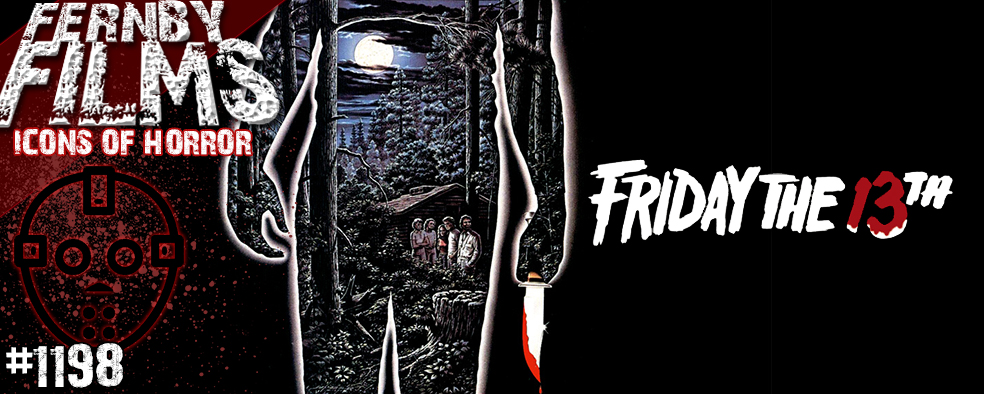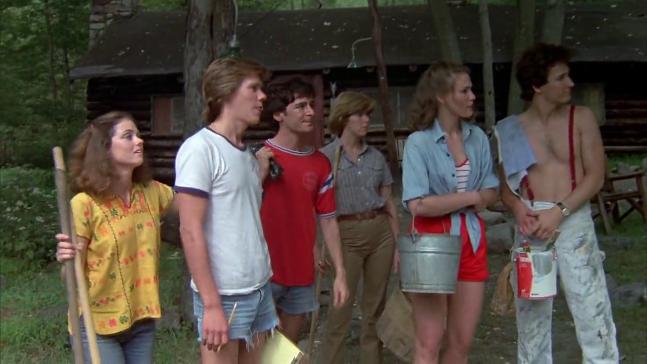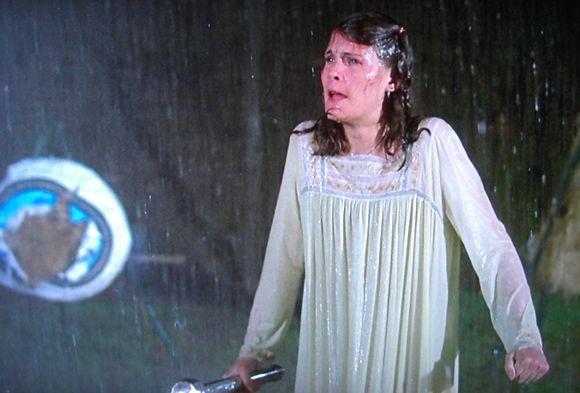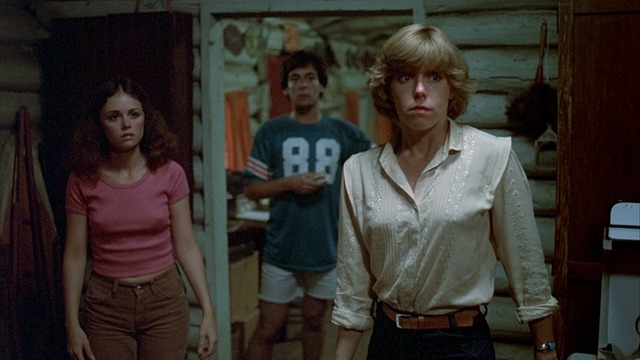Movie Review – Friday The 13th (1980)

Director : Sean S Cunningham
Year Of Release : 1980
Principal Cast : Adrienne King, Betsy Palmer, Harry Crosby, Kevin Bacon, Jeaninne Taylor, Laurie Bartram, Peter Brouwer, Mark Nelson, Robbi Morgan, Rex Everhart, Walt Gorney, Willie Adams, Debra S Hayes, Ari Lehman.
Approx Running Time : 95 Minutes
Synopsis: A group of camp counsellors is stalked and murdered by an unknown assailant while trying to reopen a summer camp which, years before, was the site of a child’s drowning.
*******
This popular 1980 slasher film took the relatively bloodless terror of John Carpenter’s Halloween and gored-up the horror genre; Friday The 13th not only became a seminal classic (not to mention an early Kevin Bacon performance) but spawned countless sequels and rip-offs, becoming a staple of the 1980’s and early 90’s, a couple of post-millennial forays and eventually a 2009 reboot. The villain of the film is not Jason Vorhees, here played by Ari Lehman, but another knife-wielding psychopath terrorising the teen counsellors at Camp Crystal Lake, a summer camp soon afflicted with a terrible problem with death. Most people have forgotten that Jason didn’t really start up until the sequel; the identity of the original film’s killer remains among the most often misremembered.
 It’s present day, Camp Crystal Lake, and six summer camp counsellors – Alice (Adrienne King), Jack (Kevin Bacon), Bill (Harry Crosby, real-life son of Hollywood icon Bing Crosby), Brenda (Laurie Bertram), Ned (Mark Nelson) and Marcie (Jeaninne Taylor), as well as camp owner Steve (Peter Brouwer), are stalked and terrorized by a horror from the past; the camp has a history of mysterious deaths, including a kid drowning and several attendees being murdered in years gone by. One by one, as the body count rises, the realisation that the killer will not stop until the lake runs red with blood.
It’s present day, Camp Crystal Lake, and six summer camp counsellors – Alice (Adrienne King), Jack (Kevin Bacon), Bill (Harry Crosby, real-life son of Hollywood icon Bing Crosby), Brenda (Laurie Bertram), Ned (Mark Nelson) and Marcie (Jeaninne Taylor), as well as camp owner Steve (Peter Brouwer), are stalked and terrorized by a horror from the past; the camp has a history of mysterious deaths, including a kid drowning and several attendees being murdered in years gone by. One by one, as the body count rises, the realisation that the killer will not stop until the lake runs red with blood.
It’s a grand archetype of the horror genre, particularly slasher films, that one should never have sex: people who have sex in horror films inevitably wind up dead in some awful manner. There’s a sinew between sex and death that makes slasher films so visceral, perhaps it’s the defencelessness of people inflagrante that makes the thought of being stabbed to death so powerful. Director Sean Cunningham works on this impactful sense of helpless victimhood, a spine-tingling sense of implacable terror of both isolation and razor-wire tension, driven primarily by both the quiet of Camp Silver Lake’s rural setting and Harry Manfredini’s suitably eerie, dread-inducing score. Thankfully, at least one couple in this film have sex.
 At it’s heart Friday The 13th is super-simple. Stick a bunch of nubile young teens in the woods, with no means of easy escape, and stick a virtually unseen psycho killer after them. The Killer is more a presence in the film than an active participant – for most of the film he’s off-camera, either shadowy shape or intimated by the bloodthirsty manner in which he butchers the kids. Cunningham uses the invisible nature of the Killer, the way he manages to get into parts of the camp unseen and largely unheard, as almost supernatural, a well timed method of ratcheting up the tension of the film’s dark, rain-soaked second act.
At it’s heart Friday The 13th is super-simple. Stick a bunch of nubile young teens in the woods, with no means of easy escape, and stick a virtually unseen psycho killer after them. The Killer is more a presence in the film than an active participant – for most of the film he’s off-camera, either shadowy shape or intimated by the bloodthirsty manner in which he butchers the kids. Cunningham uses the invisible nature of the Killer, the way he manages to get into parts of the camp unseen and largely unheard, as almost supernatural, a well timed method of ratcheting up the tension of the film’s dark, rain-soaked second act.
The film’s mood is generated early for the audience, with local townsfolk intimating the camp’s prior history with tragedy to a newbie young girl, Annie (Robbie Morgan), before she’s promptly despatched by the Killer before ever reaching her destination. This allows us to get into the head-space of the film, but not the other surviving characters. The script, by Victor Miller, doesn’t really knuckle-down the genre’s pathways in a manner befitting, say, Hitchcock’s Psycho, in which almost the entirety of that film’s creep-factor was dialogue driven, allowing Cunningham to bring his low-budget jump-scare ethos to the movie. Cunningham seems to relish in the kitschiness of it all, albeit understanding that his primary reason for making the film is to scary the bejeebers out of the viewer.
In some respects, he does this through slow, slowly building anticipation, an anticipation generated through quiet or specifically creepy audio cues, including the score. It was noted by Cunningham that the film only uses it’s “spooky” score whenever the Killer is in play, remaining otherwise music-free the rest of the time. It’s a subtle thing, but it works. Manfredini’s pulsing, string-screech music evokes Psycho (or even the relatively recently released Jaws), a skin-prickling, shuddering frisson that would become a staple of the genre lasting until even today. The second way Cunningham reaches his viewers is to place them directly in harms way. Often, the camera is the Killer, as he stalks his victims, a POV-style that works tremendously once the atmosphere of the film has been established. Other times, he uses a hand-held, off-balance camera style, as if to keep the audience as shuffle-footed as the characters in the film.
 The film’s iconic “kills” are well handled, with plenty of graphic body horror to entertain in the most salacious manner possible. Although not overly gory in the manner we’re accustomed to today, several of the film’s death scenes – notably, Kevin Bacon’s – have a brutality and realism to them that would have mortified parents of the teens seeing this film in 1980. Prosthetic makeup being what it is, it’s easy to spot the seams of this Friday’s gut-punches, but they remain largely effective for their period braggadocio.
The film’s iconic “kills” are well handled, with plenty of graphic body horror to entertain in the most salacious manner possible. Although not overly gory in the manner we’re accustomed to today, several of the film’s death scenes – notably, Kevin Bacon’s – have a brutality and realism to them that would have mortified parents of the teens seeing this film in 1980. Prosthetic makeup being what it is, it’s easy to spot the seams of this Friday’s gut-punches, but they remain largely effective for their period braggadocio.
Although many of these methods are considered passe today, overused to the point of tedium, in Friday The 13th they’re brand new, and as such have a ragged, almost trepidatious feeling to them. The film was shot for the princely sum of half a million dollars, so rather low budget, and the film’s guerilla style certainly works for the pulp genre it represents. There’s a lack of production value here that money just can’t buy – yep, it’s true. Sure, the actual scares are fewer and further between than modern horror flicks, and the body count rises quite quickly before the denouement – all but two of the film’s leads are dead before the half-way mark – but there’s a tactile sense of dread littered through what is an eloquently low-key affair. Friday The 13th does exactly what it needs to, and it does it quite well.








The trifecta of this one, Halloween and A Nightmare On Elm Street really kicked "modern" horror and slashers films right in the ass, made them more mainstream than ever before. Yep, it hasn't aged as well as, say, Halloween, but it's still the archetype by which most others are judged.
Great review! I so admire your taking it on. I myself could never look at this one objectively, as I remember seeing it for the first time and having it scare me to death, even though I was watching it on TV in the afternoon! It broke new ground by being one of the seminal slasher films and, while it certainly hasn't aged well, so much of modern horror has a debt to this one. Thanks, Rodney!